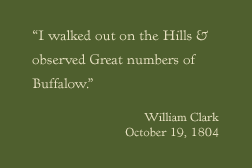

|
 |



Lesson Plan 2: Who Is a Naturalist?
OBJECTIVES
Students will:
- analyze Lewis and Clark journal entries about animals
- write a detailed animal description
- draw an image of a rare or endangered animal based only on an oral description
- understand the term "naturalist"
MATERIALS
STUDENT
READINGS |
Journal Entries Sheet (PDF)
Letter from Charles Willson Peale to Jefferson (PDF)
|
ACTIVITY
SHEET |
Document Analysis Guide
|
| SUPPLIES |
Colored pencils to draw the particular animal
Various pictures of rare, exotic, or endangered organisms that students might not be familiar with from magazines, web sites, etc. (to be assembled by teacher attaching each picture inside its own folder). Lewis and Clark saw the following animals that are now extinct or endangered: ivory-billed woodpecker, Carolina parakeet, least tern, pallid sturgeon, passenger pigeon.
|
BACKGROUND
Lewis and Clark: Across the Divide excerpt
By Carolyn Gilman (chapter 5)
Although Historians have credited Lewis and Clark with the "discovery" of a long list of animals, they did not in fact name any new species: that task was for specialists. But it was part of their mission to collect enough information so men of learning could name and classify the animals they had seen. Since the crucial information was anatomy, when they were functioning as Enlightenment observers, their attention was on the physical characteristics. They measured each part, described markings, boiled down carcasses to study bone structure, and when possible preserved skins. Their descriptions, like the illustrations of wildlife artists who followed them onto the Plains, attempted to isolate the unique characteristics of each species. Though by necessity they described individual animals, they looked for normal, representative specimens to serve as models for the whole species. Unlike earlier explorers, they were not seeking the monstrous or unusual; they sought an abstract ideal: the typical.
OPENING
Ask the question, "What is a naturalist?"
The teacher will start by discussing the following topic: When we think of how we describe ourselves to others, we may be apt to think of our style of dress or physical features. We usually assume most people know what we mean. What happens when you are asked to describe something brand new to a group of people that have no idea what it is you are talking about? This will be the challenge of the following lesson.
PROCEDURE
Lewis was instructed to describe plants, minerals, people, rivers, animals— just about everything about the West that he possibly could.
- Have students read three of the five journal entries by Lewis and Clark on the "Journal Entries" page: descriptions for rattlesnake, sea otter, badger, fish, and prairie dog. As students read carefully, tell them to look up definitions for any words they don't know and to make a list of all categories of description that Lewis and Clark use in each journal entry (i.e., color, size, texture, mannerisms).
You will need to explain that spelling was not standardized, so Lewis and Clark spelled words based on how they sounded.
- Discuss student answers and list the categories they found.
- Now give each student a rare-animal picture taped or glued inside a folder.
- Each student will then "speak" a journal entry to a fellow student, describing his or her animal and its habitat and imagining that he/she is an explorer seeing this animal for the first time. Students should attempt to use carefully detailed observation skills the way that Lewis did in his journal entries.
- Without being allowed to see the animal picture and only using the spoken journal entry as a guide, the other students should draw what they are hearing their partner describe.
- When everyone is done, pairs will hold up the drawing and the original animal picture and show the class how accurate each picture is. Partners should share with each other what details might have helped them to picture the animal more accurately.
- Switch so each partner has an opportunity to play each role.
- Ask students, "What is a naturalist?" Were Lewis and Clark naturalists? Why or why not?
Teacher Definition: Naturalist—A person who studies nature, esp. by direct observation of animals and plants. (Webster)
CLOSING
Using the Document Analysis Guide, students should read the letter from Charles Wilson Peale to Jefferson. ("Dear Sir, The Magpie is in good health....every part of the Globe!..CW Peale) Discuss the letter with the class. Ask, "What new information about Lewis's role on the expedition does it provide?"
(He not only wrote descriptions of animals, he also collected specimens for Peale's museum in Philadelphia.)
[PRINTABLE VERSION]
|
 |






